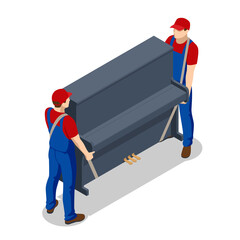A moving company can make your relocation process smoother and hassle-free. They are experienced with the complexities of moves and know how to solve problems that may arise throughout the journey.
Start by asking friends and family for recommendations. Then, research the companies online, checking customer feedback and looking for red flags.
Whether you’re moving across the street or around the country, a professional moving company can help. Some companies specialize in local moves while others provide shipping and storage options for long-distance moves. They also offer packing services and can handle large amounts of items in a short amount of time. They’ll use high-quality boxes, bubble wrap, and other materials to protect your belongings. In addition, they can pack specialty items like antiques and glassware. They’ll also load and unload your belongings onto their trucks.
When hiring a packing service, it’s best to schedule the process several weeks in advance of your move date. This allows you to pace yourself and prevents getting overwhelmed. It’s also a good idea to plan on spending more time packing than you expect, especially when it comes to non-essential items. For example, books and clothing tend to take longer to pack than electronics, furniture, and dishes. It’s also important to label each box clearly so that you know which room it belongs in and if it’s fragile.
Most packing companies will send a salesperson to your home to survey your belongings and give you an estimate of their total cost. This can be either binding or non-binding, with a binding estimate meaning that the final price won’t change. The cost of a move also depends on the size of your home and the number of items you’re transporting. Additional services like specialized transportation, disassembly and reassembly of furniture, and storage solutions are often extra, and can add to the overall cost.
Some people prefer to take on the packing process themselves. If this is the case, a self-service moving company can be an affordable option. These companies provide a rental or delivery of a mobile storage unit to your home, which you then fill up and transport to your new location. These are popular with individuals who don’t feel comfortable driving a truck or who want to keep their hands on the wheel during the move. These companies also allow you to purchase moving insurance, which is important if you’re transporting expensive articles.
Transportation
A moving company’s primary responsibility is to transport your items safely from one location to another. They use specialized trucks designed for household goods, which are equipped with features like air-ride suspension and climate control systems to keep your items in optimal condition during transit. They also have access to a range of equipment, including dollies, furniture pads, and moving straps, to help them load and unload your items.
To ensure the safety of your items, moving companies use high-quality packing materials. These include cardboard boxes, stretch wrap, bubble wrap, packing peanuts, and tape. These supplies are designed to protect your belongings from damage during transit and make it easier to pack. Professional movers have the skills and experience to pack a variety of different items, including fragile glassware and large appliances.
Your business’s name should describe what your services are and reflect the values of your brand. It should also be easy to remember, so that customers can find you easily. You should also conduct a thorough trademark search to ensure that no other companies or similar businesses are using the same name.
Creating a business plan is an important step in starting a moving company. It helps you establish a framework for your operations, which can help you define what services to offer and how much to charge for them. It can also be used to guide your marketing efforts, as it will help you develop a targeted approach to attracting and retaining customers.
The transportation process involves preparing and loading your shipment for transportation, tracking your shipment as it is in transit, and delivering your items to the final destination. A good moving company will have a team of skilled and experienced staff to handle these tasks, as well as the necessary tools to get the job done efficiently. They will also have a fleet of well-maintained trucks to transport your items safely and securely.
In addition to establishing an efficient workflow and processes, you must also provide your employees with training so that they can do their jobs safely and effectively. This includes familiarizing them with your specific moving terminology, which can be confusing for those who are not familiar with it. For example, “Warehouse Handling” refers to an additional charge that is added to your base transportation charges for storing your items in the warehouse and removing them from storage.
Storage
If you need to store your belongings for a short period of time between your move-out and move-in dates, a moving company can provide secure storage facilities. Some movers operate their own storage facilities, while others have partnerships with local storage providers to offer discounted rates. They can also transport your items to the storage facility of your choice, if necessary.
In addition to the core services of packing, transportation and loading/unloading, some moving companies also offer specialized furniture moving, piano moving, appliance service, junk removal and more. Choosing the right movers can make your relocation a smooth and efficient process, and save you time, money and stress. In addition, it can help minimize the risk of damage to your belongings. Depending on your situation, a professional moving company may be worth the investment.
Insurance
The insurance policy of a moving company is an important piece of the puzzle when it comes to a safe, successful move. While movers do not typically offer true insurance policies, they can provide a level of liability coverage for your belongings called “valuation.” Although valuation is sometimes confused with insurance, it is a much more limited form of protection.
Federal regulations require interstate movers to offer two forms of value-based reimbursement: released value protection and full replacement value coverage. Released value protection reimburses you no more than 60 cents per pound on lost or damaged items. It is included in your estimate, and you can decline it by signing a statement on your bill of lading. Full replacement coverage is optional and costs extra.
Regardless of the type of coverage you choose, reputable moving companies carry at least general liability insurance and workers’ compensation. Auto liability insurance is similar to the auto insurance you carry, protecting your company if an employee damages a customer’s personal vehicle during pickup or delivery. Professional liability insurance covers the cost of legal defense if your company is sued for mistakes or oversights that cause financial harm to a customer. Commercial umbrella insurance boosts the limits of your general liability, commercial auto, and employer’s liability insurance to pay for the most expensive lawsuits.
Many moving companies also work with third-party insurers to provide additional, more comprehensive coverage options. These third-party policies can be a good option for households with several high-value items, or for those who want a more transparent method of valuation.
While a separate liability policy will cost more than your mover’s released value protection, it is worth the investment if you have valuable items that you cannot afford to lose or damage during transportation. Depending on your budget, you may even be able to find coverage for your entire shipment through a third-party policy. It’s always best to get the details of any policy you purchase from a third-party insurer in writing so that there is no confusion about what is and is not covered.






